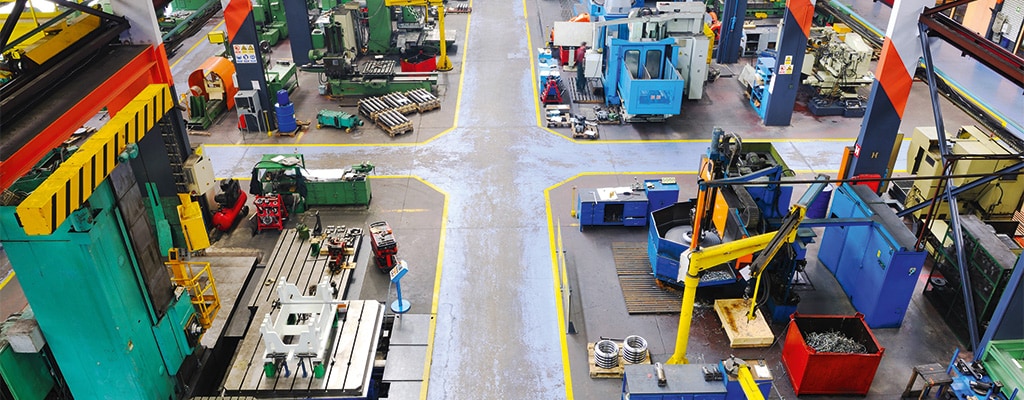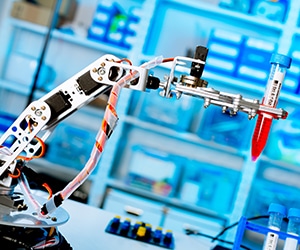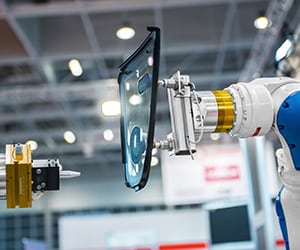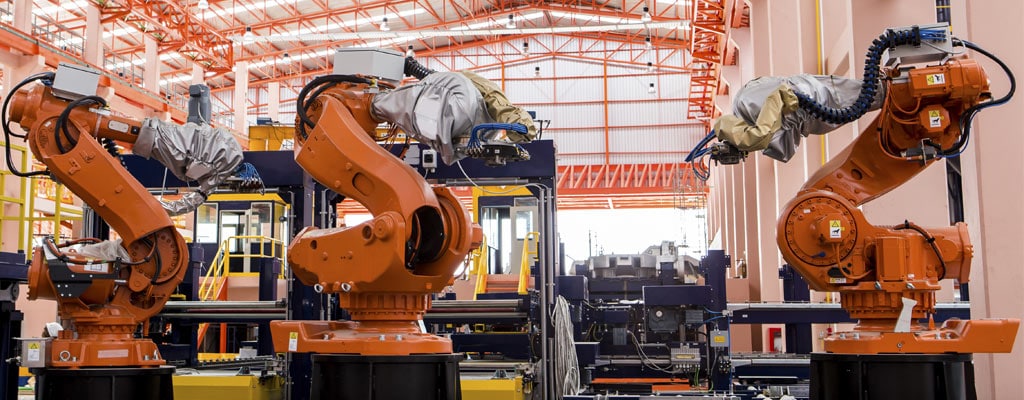
M2M Connectivity
Trend Insight
Optimize for Interoperability
M2M communications can integrate production processes. Learn about the prerequisites and benefits of engineering M2M connectivity for industrial technology.
Each day, the media publishes new stories about the Internet of Things (IoT), often focusing on the promises and perils of enabling machines to communicate autonomously with other machines. While many of these stories look at self-acting or remotely hacked machines posing a threat to humans, the IoT story not often told is about how machines – equipped with sensors, programmed (by humans) with rules – can effectively communicate specific sets of data to other machines, which in turn use the data to efficiently, precisely, and safely perform certain crucial steps. The idea is to advance what we know as machine-to-machine (M2M) communications, by creating a network of self-monitoring, adaptive learning machines with the capacity to generate and transmit data – in real-time – in ways that offer immediate, complex interoperability designed to serve specific human requirements.
For manufacturers, not enabling machines to communicate is a missed opportunity to coordinate production activity.
Achieving this level of integrated performance, however, is quite distant from the examples we mostly see today. Presently, much of the IoT discussion is happening in the consumer space, where IoT is discussed in relation to how devices provide conveniences that make our daily tasks easier: If we want to change the channel on our TV, or switch to another radio station, or adjust the brightness of your lights or the temperature in the room, you can simply press a button on, for example, a mobile device. This level of connectivity is about remote functionality rather than M2M integration.
Basics of Interoperability
The significant possibilities emerge when we think about IoT in relation to machines which learn from our behavior and their own environment. One example is the NEST thermostat. However, its capacity to detect and process input about human preferences, and then use this information to predict a building’s interior temperature, is only a glimpse of what we can achieve. To take this connectivity to the next level, consider this possibility: Each weekday you typically arrive home at 6:00 pm, and your NEST thermostat knows this and responds by heating your home so that when you arrive at 6:00 pm, the interior reaches the right temperature you desire. But then one day, while driving home from the office, you encounter travel delays resulting from traffic congestion, which causes you to run about 20 minutes later than usual. Your car’s system detects this delay, calculates its impact, and then transmits a new arrival time to the thermostat, which responds by reprogramming itself so that it syncs its operation – of preheating/precooling to the desired temperature – with your expected arrival time as well as current and forecast weather conditions. The result is less energy used in the home, which translates into lower energy costs for you. This type of scenario, especially on a larger scale of entire buildings and cities, is where we start to see significant benefits from embedding smart connectivity into machines. This is when IoT becomes part of an overarching strategy for improving long-term cost performance, resource allocation, and overall convenience.

M2M connectivity is crucial for enabling automation in today's digital factory.
Presently in industrial environments, there is little M2M communications. What we mostly have today are machines that require humans to complete a single, repetitive task. An analogy is a football team: If the players on the field fail to communicate, each is acting in isolation, and together they will not reach their goal: winning the game. Transpose this analogy to an industrial setting, and you have machines and robots in a factory today that are not talking, and the data which these machines generate stays local to each machine. This non-integrated system lacks the flexibility to perform high-value tasks as needed. For manufacturers, not enabling machines to communicate is a missed opportunity to coordinate production activity. From this type of failure comes redundant processes, frequent downtimes for changeovers, and machines running when not needed.
Reaching this point successfully and affordably requires first-time-right approach to production, where IoT-enabled M2M communications could be the enabler.
In the smart factory, the machines and robots are equipped with the technology – hardware and software – that enable M2M communication and interoperability. This technology facilitates the transfer of data in one machine to other machines in the same factory – as well as to the infrastructure and to users connected through the Internet, through all types of other devices, such as smartphones and smart garments. Through this transfer – this smart connectivity, machines generate raw data, communicate it to other machines (as well as to networks and clouds), and then through techniques such as Big Data analytics, process it into real-time visualizations of production. From this information, machines can autonomously make decisions about possible actions – within the parameters of specific patterns and rules (which engineers program into the machine’s operating system) tailored to achieve certain types of operational efficiency improvements, such as shifting into pause mode immediately after it completes a production task, as a way to reduce energy use. These rules and patterns also enable unprecedented flexibility in production.


From a top-level view in factories, everything is controlled by consumers. And as consumers, we all want each new version of a product to be better, faster, cheaper, and more efficient – and we want more customization to our individual preferences and requirements, because each of us wants to express ourselves as individuals within our mass-production world. The MINI passenger car is a prime example of such customization, customers can select from among a diverse range of available options to build what they believe is a unique vehicle, one that they helped create and which represents their individuality. Getting this level of customization in mass production requires a completely new approach to production. To do this, we need something like batch size one, which is the ultimate aspiration – and not impossible for things such as unique mobile phones. Reaching this point successfully and affordably requires first-time-right approach to production, where IoT-enabled M2M communications could be the enabler. Without this approach, achieving customization with current production approaches makes the cost of a unique mobile phone very high.
Prerequisites for M2M Connectivity
Enabling Change
Transitioning a conventional factory into a smart factory involves meeting four crucial prerequisites:
Standardization
Standardization is a double-edged blade. On one hand, there is a need for standards to professionalize the approach and to guarantee interoperability, but it takes time to identify and establish the standards. This time delay can slow down adoption. And with this, once an approach becomes a standard, it can dissuade innovation because people might oppose deviating from the standard – especially when Big Data becomes part of the conversation. The challenge is that technology evolves and matures very quickly, and often, the standards cannot keep pace with the speed of this innovation. The result could be that the standards inhibit opportunities for growth. Yet, moving forward – and not continuously reinventing the wheel – is only possible when we have some standards in place.
Smart Connectivity
Smart connectivity, which also involves interoperability, enabling plug-and-play solutions for a wide variety of devices and machines. The building blocks of smart connectivity comprise of sensing and connectivity. Sensors create a digital nervous system and connectivity enables networked inputs. These networked inputs are digitized inputs (coming from sensors) onto networks and/or clouds, which have to be integrated with machines and operations to support people, processes, and systems, for the purpose of improving decision making. In industrial environments today, many machines are not connected, and therefore not communicating. Once you start looking at connecting these machines, you need to think about the amount of data these machines generate. In most cases today, this data is still limited. To fully benefit from using IoT in production, manufacturers need more sensing inside their machines and they need to unlock all the data so it can contribute into networked inputs for better decision making.
By running small programs that generate required quality, expected outcomes, and significant ROI quickly, engineers can establish clear paths for driving IoT improvements.

Security
When it comes to Big Data, clouds, and IoT, there is much fear around security and protection of the machines and the data. There are stories of hackers taking over autonomous vehicles and accelerating or braking from a distance. These cases are terrifying. This area needs more attention. And with protection comes the need to think about the data. There is need for legislation about the data, specifically about who owns the data and how it is transmitted and managed.
Short-Term ROI
A clear return generated from a small investment builds the case for convincing longer-term support and buy in for larger M2M improvements. In industrial environments, where it is commonly expected that return on investment (ROI) will be high – but difficult to predict or articulate meaningfully and concretely for senior leadership, it is crucial to start small and proof the business case quickly. The cost of reconfiguring a conventional factory into a smart factory – adding new infrastructure, connectivity, clouds, and analysis tools – is very high. This – and the lack of clear ROI expectations – often make getting buy in very difficult. By running small programs that generate required quality, expected outcomes, and significant ROI quickly, engineers can establish clear paths for driving IoT improvements.
Benefits of M2M Connectivity
Despite the hype and hyperbole common to most discussions about IoT, there is increasing recognition about the potential significant ROI which manufacturers can generate from smart connectivity. This is the key to helping a manufacturer turn a conventional factory into a smart – or connected – factory. To get there, senior leaders need realistic snapshots of the success which can be achieved, and they need to understand how IoT can directly result in significant production increases and waste reductions. To satisfy these information needs, engineers need to first answer a crucial question when making a case for IoT investments: Is expected performance improvement a direct result of IoT – or will IoT only make improvements easier? To answer this, build a case around the three benefits of investing in IoT.
Cost Savings
The primary savings is related to gains in operational efficiency. As adoption takes hold and happens on mass scale, the cost of change – of adoption and implementation – will also lower.
Transparency
Gaining greater insight into operations will help manufacturers identify where improvements can occur. For example, by tracking the entire production lifecycle of a product, you could track the actual cost to make each individual unit – which would enable you to set more accurate prices – and collect data on what changes have an effect on the lifetime or performance of products. You could also determine if the product is to the right spec – over or under spec – in relation to its use. And you could monitor a product over its lifetime and track how it performs as conditions change. This transparency would enable you to provide information to the user about the product’s performance, including when it is likely to fail – so that they can order and replace the product in a timely way, before failure occurs. This enables them to avoid unscheduled downtime.
Energy Efficiency
Using IoT-connected machines leads to more responsible energy use. By connecting all machines, you can measure the amount of time that certain machines are running: This means that machines will only operate when needed, based on the data that the network of machines is communicated through the connected factory. And if a machine experiences a failure and shuts down, the other machines can immediately respond and subsequently either slowdown production or alter production processes as needed – and as the machines are programmed to resolve.

In the connected factory, machines measure and communicate crucial information that improves response time.
Over the next few years, there will come a point when manufacturers will need to invest in IoT technology. To get there, the engineering community needs to communicate individual successes to each other, to organizations, and to the larger business community. Presently in Germany, Industrie 4.0 – the Industrial IoT – is perceived as the fourth revolution of industrial life. Which calls to mind the story of Henry Ford. When Mr. Ford started, he was competing with the horse-and-carriage, and there were many people who were saying that the automobile would never replace the horse-and-carriage, which was the then-standard form of daily travel. But as we now know, that standard way of doing things was replaced with a new better way to travel and to think about travel.
Build Your Success Story
To demonstrate the potential good of IoT, engineers need to show what IoT revolution means to business performance. In building your success stories, start small, build solid proof points based on provable data; start on one machine, document the savings achieved, and then craft a success story and scale the potential gains across your organization. These stories will help counter the commonly held IoT biases and fears – and can instead help instill confidence in IoT, smart connectivity, and the connected factory. By showing the advantage of connecting machines, we can show business leaders that their organization can generate higher outputs, experience less unscheduled downtime, increase operational flexibility, and improve yields, all by simply better connecting and integrating all touch points along the production line.

